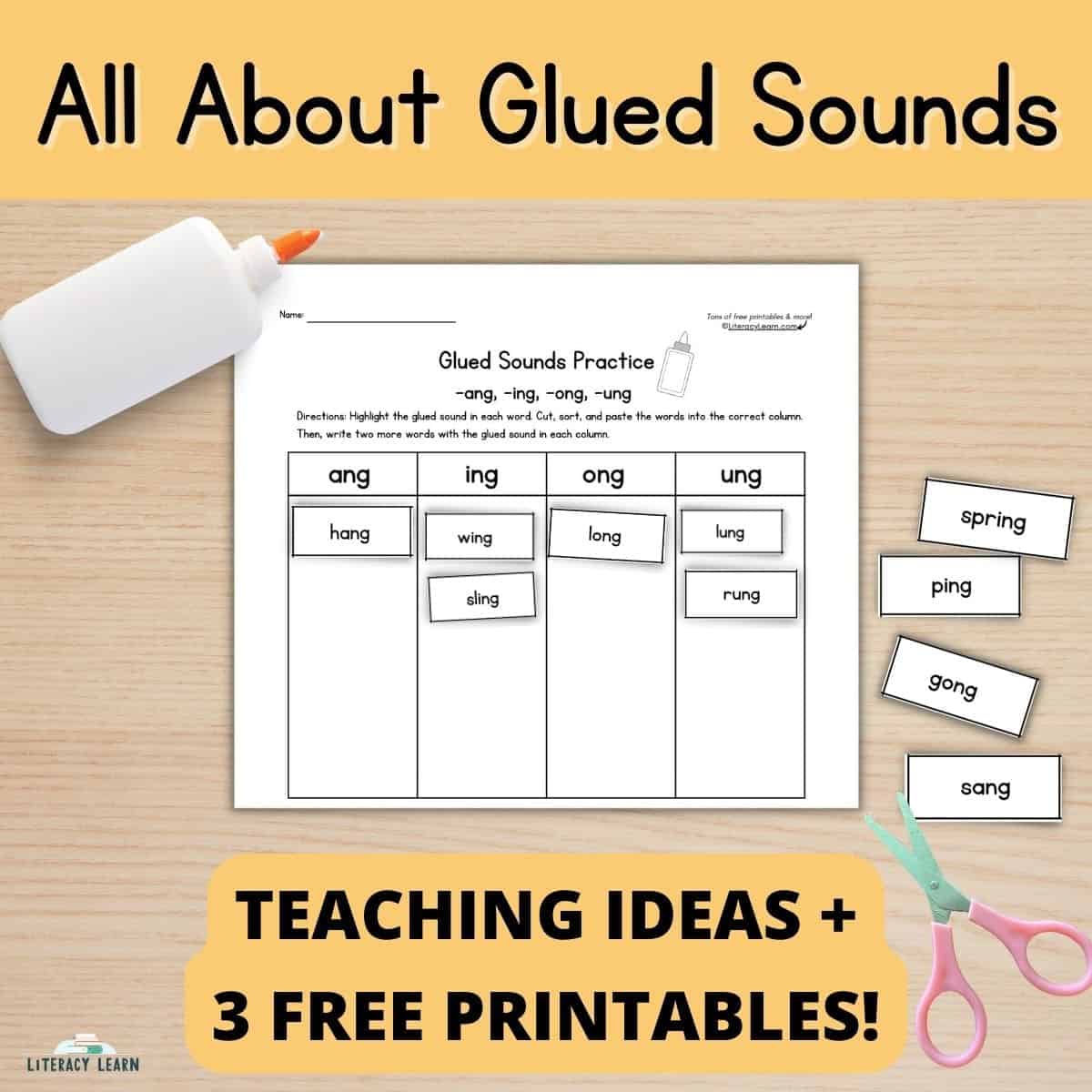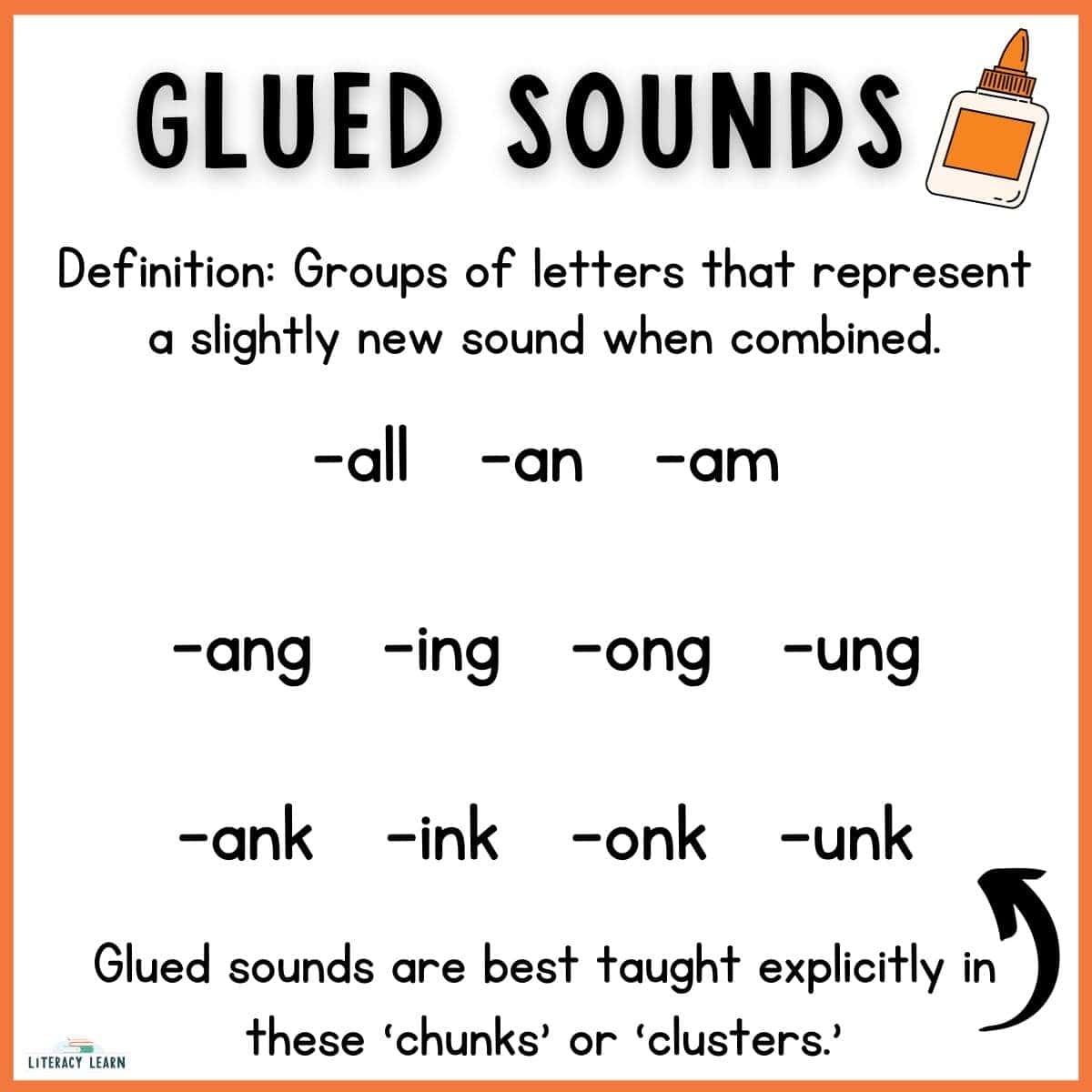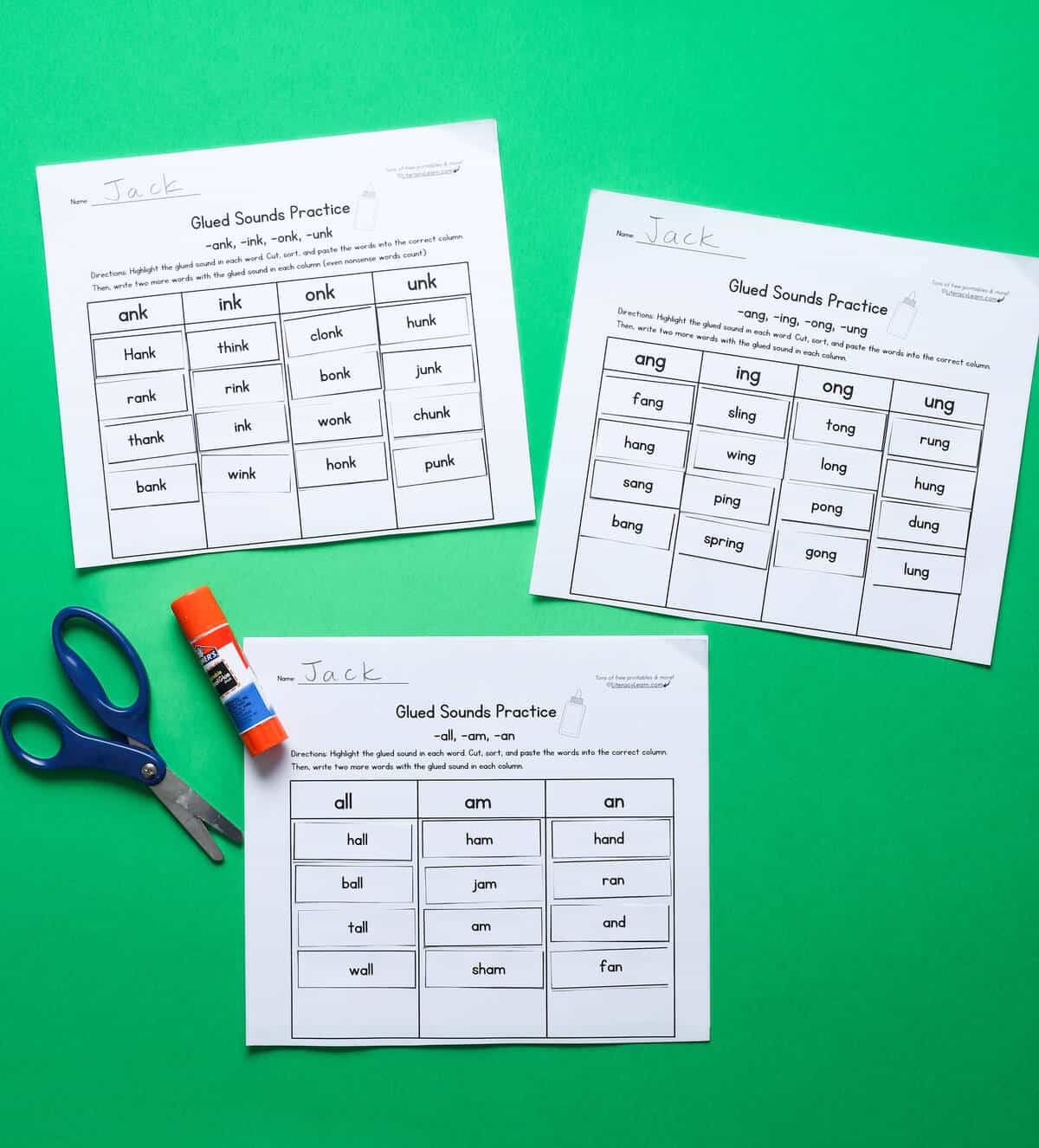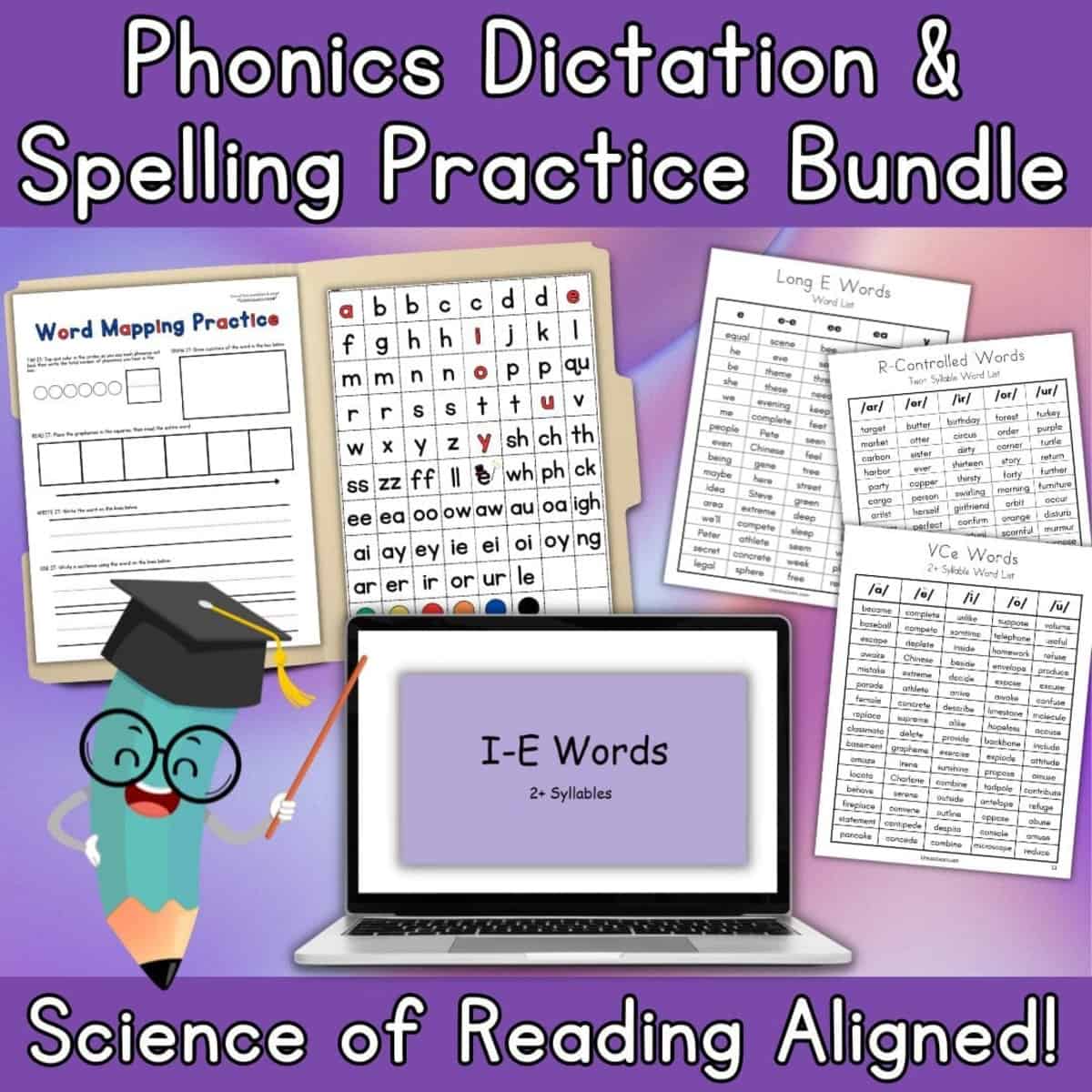All About Glued Sounds: Teaching Tips + Free Printables
This post may contain affiliate links. As an Amazon affiliate, we earn from qualifying purchases. See our disclosure policy.
Learn all about the different types of glued sounds and get practical teaching tips for helping students master the concept. You’ll also get 3 free worksheets to help your students practice accurate reading and spelling.

What Are Glued Sounds?
Have you ever wondered why words like can or ham don’t have a true short vowel sound? Or why words like wing or tank have sounds that seem to get left out? It’s because these words include glued sounds!
Glued sounds are groups of letters that stick together when we say them in a word. Instead of saying each letter’s sound separately, they create a slightly new sound when combined. It’s like they’re glued or stuck together, making it a bit tricky to hear each letter on its own.
When these letters are next to one another, they create a slightly different sound together. This is what we refer to as a ‘glued sound.’ Glued sounds are sometimes called welded sounds, too.
Glued sounds include: -am, -an, -all, -ang, -ing, -ong, -ung, -ank, -ink, -onk, -unk.

Glued sounds will always appear at the end of a base word or syllable.
Glued Sounds With Two Sounds
The glued sounds -all, -am, and -an include two sounds. The a does not represent the short /ă/ sound that you’d expect in a closed syllable.
In the glued sound -all, the digraph ll changes the vowel to a broad a, making it sound more like a short /ŏ/ sound, like in the words ball, tall, stall, and small.
In the glued sounds -am and -an, the vowel is followed by a nasal sound, which impacts the sound of the vowel. The vowel sound becomes nasalized, or whiny. Some teachers refer to this sound as the Whiny A.
These sounds are best to introduce to young students, usually in early first grade. This can be taught after they have a solid understanding of CVC words and digraphs.
Glued Sounds With Three Sounds
The glued sounds -ang, -ing, -ong, -ung & -ank, -ink, -onk, -unk include three sounds. In these letter combinations, some portion of the sound slightly changes.
It is best to teach these sounds in two different groups: vowel + ng and vowel + nk.

Teaching Tips
Glued sounds can be quite tricky for kids who are learning to decode or encode words with these sounds. That’s why explicit teaching needs to happen.
Start with Speech
It’s great practice to begin with speech before moving to text. You can do simple phonological awareness activities where kids are asked to blend, segment, or manipulate words with glued sounds orally. Here are some activities you might consider:
- Blending: “I’m going to say some words, but I’m going to say them with a space between the onset (first sound) and rime (vowel plus any ending sounds). Your job is to tell me what word I am saying.” /b/+/ing/=(bing). /S/+/am/=(Sam), /t/+/ank/=(tank), /j/+/unk/=(junk).
- Segmenting: “Now let’s segment, or separate, some words into onset and rime.” Hank=/h/+/ank/, ball=/b/+/all/, ring=/r/+/ing/, fan = /f/+/an/
- Phoneme Manipulation: “Now let’s manipulate, or change, some sounds in words. The word is bing. Change the /i/ to /a/ – bang. Now change the /g/ to /k/ (bank). Now delete the /k/ sound at the end – ban. Now change /n/ to /m/ – bam.”
This provides the perfect transition into explicit teaching as you move from speech to print.
Provide Explicit Teaching
Follow your scope and sequence and introduce these glued sounds at the appropriate time, in an order that makes sense.
I recommend introducing this concept using actual GLUE! I love to take simple letter cards, grab a glue gun, and actually glue the letters together as I teach the concept. Even better…. use magnetic letters if you have extra.
Using a word like can, take the letters and produce the sounds each letter represents individually, using finger tapping – /c/ /a/ /n/.
But, as you glue the letters together, explain how some portion of sound in all of the word slightly changes (in this case, short a).
So, in order to represent the actual sound, we remember the sounds better when they’re glued together – a+n says /an/ (with a nasalized a sound).
You can introduce all the glued sounds this way, as tell your students they need to recognize them as ‘chunks’ or ‘clusters.’ Kids can quickly write these letters, cut and GLUE them together on another sheet of paper, and use them headers in their phonics notebooks!

Use Targeted Practice Activities
Different programs and teachers may have different opinions about how to best teach glued sounds. One thing most educators agree on is that kids need explicit practice reading and spelling words that include these sounds.
Reading Activities include:
- Sorting – Sorting is an excellent activity for kids to visually see the patterns in words that create these glued sounds. After kids sort the words, they can practice reading the words, listening to the same sounds that occur within different words. Our free worksheets are designed with these things in mind. (Grab them at the bottom of this post).
- Decodables – Use various controlled texts to help your students practice reading words with glued sounds. To access some free options, visit our post on free decodables. You can also read our review of some of the best decodable options out there.
Spelling Activities include:
- Spelling Games – Use our popular Spell Out Loud game – where kids practice spelling targeted words as they complete various fun tasks. You can also use our Spelling Tic Tac Toe game!
- Dictation Activities – Provide lots of word and sentence dictation. Our no-prep word lists are super helpful.
- Word Mapping using Sound Boxes – Orthographic mapping should be used when practicing spelling words with glued sounds. Educators have different opinions on this one. Some think glued sounds should be included in one elkonin box, while others believe they should be separated. To maintain consistency, our view is similar to that of mapping consonant blends. Even though the blend is said very fast, it is comprised of multiple, independent sounds. So for spelling, each sound should appear in one sound box. Just remember, -ng (represented /ŋ/) is one sound, so that goes in one sound box, just like any other digraph.

More Teaching Tips
👉 When introducing the glued sounds with the nasal velar consonant ng, you can temporarily add the chunks -ang, -ing, -ong, -ung to your sound wall under the /ŋ/.
I’ve found that adding these glued sound chunks helps kids when reading/writing these tricky sounds during their independent work.
Pro tip: I also add irregular words to my sound wall! For free heart word cards that can easily be added to any sound wall, visit our post that includes 100 printable Dolch words.
👉 When introducing the glued sounds with ending blend -nk, be sure to provide spiral review about beginning blends and ending blends. Visit our phonics category page to grab lots of free blend resources.
👉 Add all of the glued sounds chunks to your sound deck card and include them with daily review.
Conclusion
As a reading specialist, I always knew about teaching word families, but never heard about the term ‘glued’ or ‘welded’ sounds. It wasn’t until my district brought Wilson’s Fundations into our K-3 classrooms that I learned this term.
Various structured literacy programs teach these in different ways. But I saw HUGE success with my struggling students when I taught these as glued sounds. When introducing the terms, using actual ‘glue’ really made the connection lightbulbs go off, helping the concepts to stick when my students encountered words with glued sounds in text.
We hope these resources provide you with the practical resources needed to help your students master glued sounds!
Download & Print
DOWNLOAD TERMS: All of our resources and printables are designed for personal use only in homes and classrooms. Each teacher must download his or her own copy. Please do not save to a shared drive, reproduce our resources on the web, or make photocopies for anyone besides your own students. To share with others, please use the social share links provided or distribute the link to the blog post so others can download their own copies. Your support in this allows us to keep making free resources for everyone! Please see our Creative Credits page for information about the licensed clipart we use. If you have any questions or concerns regarding our terms, please email us. Thank you!
We’d love to hear about your experience using these glued sound word sorts!
Please leave a comment below or tag us on Instagram @literacylearn!

